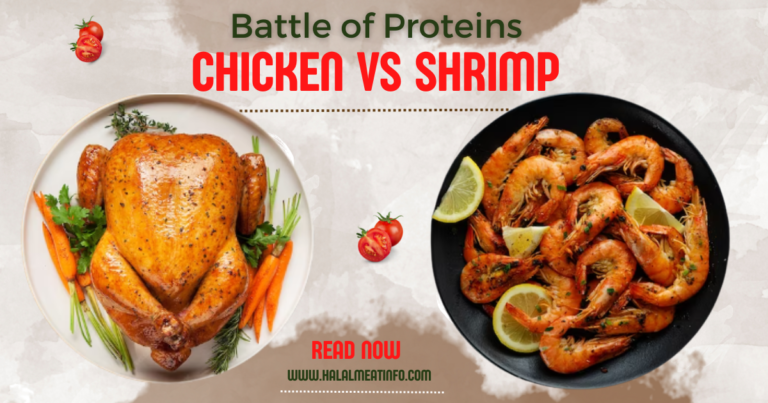Is Dark Meat Chicken Bad for You?
Certain health advocates, who also tend to favor chicken with lighter meat, frequently view chicken with dark meat as “unhealthy”. However, is it accurate to generalize about this favorite fowl so much? This post seeks to clarify any misunderstandings regarding the nutritional value of dark chicken meat and offer guidance on making well-informed dietary decisions. So let’s get started and answer the question: is dark meat chicken bad for you?

Understanding Dark Meat and White Meat
It is common practice to classify chicken as either “dark” or “white” meat. The primary differentiator is the origin of the meat’s muscles. The legs and thighs of a chicken, which are utilized for prolonged activity, are the sources of dark meat. Myoglobin is a protein that carries oxygen in muscle cells; a higher concentration in these muscles means that they need more oxygen, which is why they are darker in color.
However, white meat can be found in the chicken’s breast and wings. These parts of the bird contain muscles that are responsible for short bursts of activity and do not need as much oxygen or myoglobin as the rest of the bird. This process gives the meat a slightly distinct texture and a lighter shade.
Nutrient Profiles of Dark Meat vs White Meat
When it comes to vitamin profiles, black and white chicken meat offer distinct advantages. Dark meat contains minerals such as iron, zinc, riboflavin, thiamine, and vitamins B6 and B12. It also has more fat and calories than white meat, but these are good monounsaturated fats.
White meat, on the other hand, contains fewer calories and fat, making it a popular choice for dieters. It’s high in protein and contains plenty of key elements like phosphorus, niacin, and selenium. Despite their differences, both types of meat are beneficial additions to a healthy diet.
The Nutritional Upside of Dark Meat
Dark meat, which is often overlooked, is surprisingly high in vitamins and minerals. It is high in iron, which is essential for transporting oxygen throughout the body and avoiding iron deficiency anemia. Zinc, another mineral found in dark meat, is essential for immune system function, wound healing, and DNA synthesis. Vitamins B6 and B12, which are similarly plentiful in dark meat, are needed for brain growth and function, as well as red blood cell synthesis.
Furthermore, dark meat includes nutritious monounsaturated fats. These fats are heart-healthy and help to lower bad cholesterol (LDL) while increasing good cholesterol (HDL). They also help the body absorb fat-soluble vitamins (A, D, E, and K), which promotes brain function and provides important fatty acids for biological activities. Indeed, when consumed in moderation as part of a well-balanced diet, dark meat can be a nutritious option with numerous health benefits.
Potential Drawbacks of Dark Meat
While dark meat does provide a variety of nutritional benefits, it is also important to acknowledge its potential drawbacks.
Higher Fat Content
Dark meat is heavier in fat than white meat, particularly in saturated fats. Although it contains healthy monounsaturated fats, its increased overall fat level makes it more calorically dense. As a result, folks who are watching their calorie intake or attempting to lose weight may find that eating too much dark meat interferes with their progress.
Relation to Cholesterol and Heart Diseases
Dark meat contains a larger proportion of saturated fats, which can contribute to an increase in low-density lipoprotein (LDL), also known as ‘bad cholesterol’. Elevated LDL cholesterol levels can cause cholesterol to accumulate in the arteries, potentially resulting in heart disease. However, it is important to note that dietary cholesterol is only one of several factors impacting blood cholesterol levels, and overall eating habits and lifestyle choices have a greater impact on heart health. As a result, eating dark meat in moderation as part of a healthy diet is unlikely to pose a substantial risk.
Comparison with Other Meats
Dark Meat Chicken vs. Red Meat
When comparing dark meat chicken to red meats like beef and lamb, the differences become more evident. Dark meat chicken contains less calories, less fat, and a higher protein density than most other cuts of red meat. While red meat is high in iron and vitamin B12, it also contains a lot of saturated fat and cholesterol. Excessive red meat eating has been related to an increased risk of heart disease and certain types of cancer. On the other hand, modest eating of dark meat chicken can supply necessary nutrients while not significantly increasing the risk of these diseases.
Dark Meat Chicken vs. White Meat Chicken
When it comes to poultry, both dark and white meat chicken are healthy options, with each providing specific nutritional benefits. As previously said, dark meat has more vitamins and minerals, like iron, zinc, and B vitamins, but it also includes more fat and calories than white meat. White flesh chicken, on the other hand, has fewer fats and calories and a higher protein level, making it a better choice for individuals on weight loss regimens or trying to improve their protein intake.
Impact of Cooking Methods on Nutritional Content
Different cooking methods can significantly affect the nutritional content of dark meat. They can influence the calorie, fat, and nutrient density, often altering the overall health quotient of the meat.
Frying
Frying is a popular cooking method due to its convenience and the pleasing flavor and texture it lends to meat. However, frying, especially deep frying, can significantly increase calorie and fat content due to the additional oil absorbed during the cooking process. If the oil is warmed, it may produce hazardous chemicals such as trans fats.
Grilling
Grilling is a healthier option than frying. It requires less extra fat, which helps to keep the calorie count low. The high heat can also aid in minimizing the fat content of the meat, which drips away when cooking. However, grilling at high temperatures can produce potentially hazardous substances such as heterocyclic amines and polycyclic aromatic hydrocarbons, particularly if the meat is scorched.
Baking
Another nutritious way to cook dark meat is to bake it. The natural flavors may really pop, and there’s no need to add any extra fat. Compared to high-heat procedures, moderate-heat baking can maintain more nutrients. Nutrient loss can still occur due to overcooking, especially with heat-sensitive vitamins.
Roasting
When cooking larger cuts of meat, roasting is a good alternative to baking because it uses less fat. Without adding any extra fat or calories, it produces a tasty product. Nutritional value can be diminished when foods are heated to high temperatures for long periods of time, just as when baking.
Healthiest Ways to Cook Dark Meat
Cooking dark meat chicken at moderate temperatures with less additional oil is the best option. Because they keep more nutrients and reduce calorie intake, baking and roasting tend to be the favored methods. You can amp up the flavor without loading up on calories by using marinades, herbs, and spices. In order to keep the meat’s nutrition and avoid damaging substances, it’s best not to char or overcook it. The trick to eating dark meat healthily is to consume it in moderation and in a variety of ways.
Incorporating Dark Meat into a Balanced Diet
The amount and frequency of servings of dark meat must be carefully considered when adding it to a healthy diet plan. approximately three ounces (approximately the size of a deck of cards) of cooked dark meat, like chicken thighs or drumsticks, is the standard serving size. While planning your weekly protein intake, it’s a good idea to eat a range of foods, including dark meat poultry, white meat chicken, lean cuts of red meat, seafood, and plant-based proteins. Try to incorporate dark meat fowl once or twice a week.
Complementary Foods for a Nutritious Meal
If you know what to eat with dark meat, you can make a balanced, nutrient-dense dinner. Vegetables, for example, can supply essential nutrients like vitamins and minerals as well as fiber and keep the calorie count down. Optimal sources of complex carbs for energy include starchy veggies, whole grains, and legumes. Avocados and olive oil are good sources of healthy fat that can increase nutrient absorption and make you feel fuller for longer. Enjoy the health benefits of dark meat without sacrificing variety in your diet by eating a well-rounded diet. Never forget that the whole is greater than the sum of its parts when it comes to providing your body with the nutrients it needs.
Making Informed Choices
In the end, it all comes down to individual preferences and health objectives when deciding if dark flesh chicken is hazardous for you. There is a bigger fat content than in white meat, but it also has a ton of healthy nutrients that help with general health. Consuming reasonable quantities of dark meat as part of a balanced diet is likely to have no negative impact on health, as is the case with any meal. In addition, the total nutritional content of dark meat is highly dependent on cooking techniques. One way to make a healthier food is to avoid deep-frying and instead use healthy cooking methods like grilling or baking. This will greatly lower the fat level.
FAQs
No, dark meat chicken is not unhealthy. It contains more fats than white meat, but also provides many essential nutrients.
Baking or roasting are often considered the best methods as they preserve more nutrients and add fewer calories.
Including dark meat poultry once or twice a week in your diet, along with a variety of other protein sources, can help maintain a balanced diet.
Yes, different cooking methods can significantly affect the nutritional content, calorie, and fat density of dark meat.
A typical serving size is about three ounces cooked, roughly the size of a deck of cards.
Conclusion
In conclusion, a healthy diet can include dark meat chicken. The fat content is higher than that of white meat, but it provides a variety of nutrients that are good for you in general. The trick is to eat it with awareness, use healthy cooking methods, and eat a range of other proteins and foods to keep it in balance. The key is to eat a variety of foods in moderation. You should be able to incorporate dark meat chicken into your meal planning with confidence after reading this article. Always keep in mind that the key to optimal nutrition is a balanced diet.






